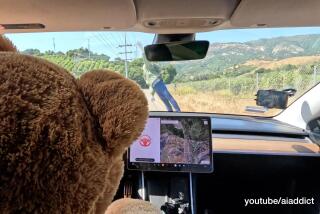Mercedes-Benz reveals recent test of self-driving car
- Share via
In yet another sign that self-driving cars are rapidly approaching reality, Mercedes-Benz announced Monday that it had successfully driven an autonomous S-Class sedan 62 miles on German city streets.
The test, which happened at the end of August, used a full-size 2014 S500 with only slight modifications beyond what is available on the production car. The route took the car from Mannheim to Pforzheim, Germany, and traveled through both city and highway conditions on open city roads.
“For us, autonomous vehicles are an important step on the way to accident-free driving,” said Dieter Zetsche, chief executive of Daimler AG and head of Mercedes-Benz. “They will bring greater comfort and safety for all road users.”
PHOTOS: Mercedes’ autonomous test car
Mercedes isn’t the only company taking a serious look at self-driving cars. Nissan, Volvo, Audi, General Motors, Ford and Toyota are among the automakers working to bring the technology to the road. Many say they will do so before 2020.
PHOTOS: Highlights of the 2013 Frankfurt show
Many luxury cars available today come with features that will serve as the underlying technology for these vehicles. Lane departure warning and assist systems keep vehicles in their lanes, adaptive cruise control can take cars from zero mph up to cruising speed without driver assistance and proactive braking systems will slow the vehicle before the driver has time to react.
Since the 2014 S-Class (which will go on sale in the U.S. in October as the S550) is available with many of these features, upgrading the test vehicle was a straightforward process.
Mercedes added two long-range radar systems to the front and one to the rear of the car, four short-range radar systems for the corners of the vehicle, a camera to detect traffic lights, and an additional camera aimed out the rear window to scan the surroundings and compare them to a previously installed 3-D digital map.
By using this final camera, Mercedes said it was possible to determine the car’s specific location more accurately than is possible with just GPS. Mercedes created these digital maps with the help of a division of Nokia, with the automaker saying the two would continue to develop 3-D maps for future autonomous cars.
Despite Mercedes’ preparation for the route, the automaker admitted that there were still kinks in the system to work out. Among these are how to communicate with other vehicles on the road, such as at intersections where another car or pedestrian waves the autonomous vehicle through.
“This sometimes results in comical situations,” said Ralf Herrtwich, head of driver assistance and suspension systems at Daimler. He pointed out that there were situation where “the vehicle gets waved through by the pedestrian -- yet our car stoically continues to wait, because we failed to anticipate such politeness when we programmed the system.”
Other hurdles for self-driving cars include being allowed on public roads. In the U.S., only California, Nevada and Florida currently allow driverless cars. In Europe, the laws allow “corrective steering functions” but not automated steering above 6.2 mph, Mercedes said.
Furthermore, European Union law dictates that a driver be in constant control of the vehicle and able to override the autonomous system at any time, the automaker said.
“As autonomous vehicles were still out of the question at the time this convention was adopted, clarification is needed with regard to what this means for highly or fully automated vehicles,” Mercedes said.
ALSO:
Fun stuff from the upcoming Frankfurt Auto Show
Lexus teases wild, all-new crossover ahead of Frankfurt
Jaguar releases crossover concept ahead of Frankfurt debut







